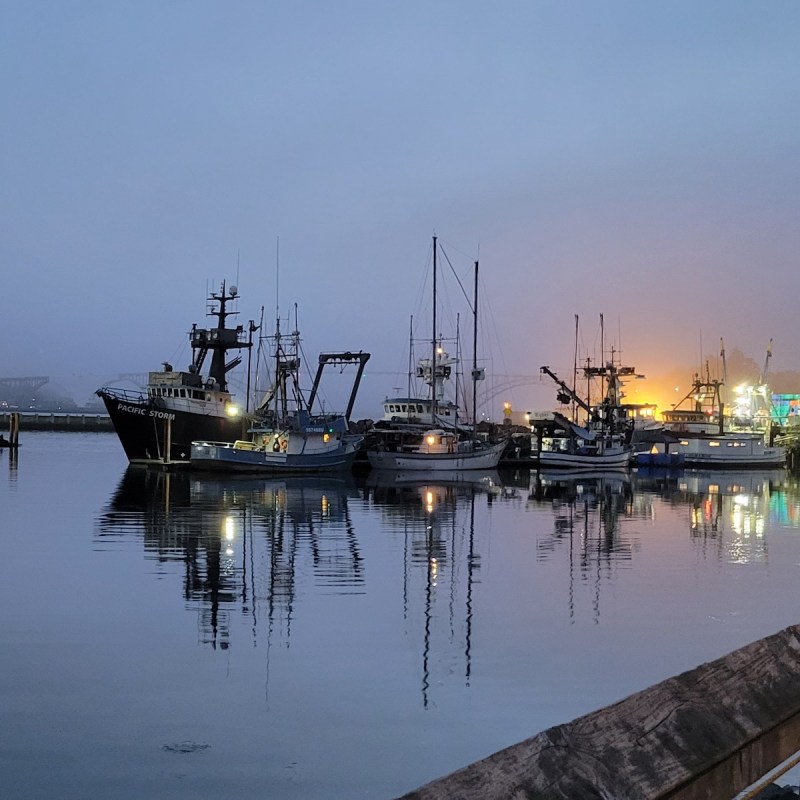
The rugged beauty of the Pacific Ocean is on full display as you drive the 363 miles of Highway 101 along the entire Oregon Coast, weaving through quaint seaside towns past an array of stunning scenery and incredible opportunities to spot wildlife. There are countless pull-outs along the road allowing you to stop as much as you wish to take in views of waves crashing against jagged rocks to the west and thick Sitka spruce and western hemlock forests cloaking the hills to the east.
Videos by TravelAwaits
The southern section of the highway meanders through small fishing villages tucked into inland bays, then begins to wind and rise above the ocean over towering cliffs. Towns catering to visitors such as Cannon Beach and Seaside provide a chance to stretch your legs and stroll boardwalks lined with numerous dining options and boutique shops. Astoria is your last stop on the highway’s northern border where the Columbia River pours into the Pacific Ocean.
Come with me on a journey up the amazing Oregon Coast as we stop at my favorite places along and just off Highway 101.

1. South Slough National Estuarine Research Reserve
Estuaries are defined as areas where rivers and streams meet the ocean. This coming together of fresh and salt water creates a variety of environments, from forests to marshes to mudflats, with each environment hosting a staggering array of wildlife.
The South Slough National Estuarine Research Reserve is located 8.5 miles off the highway and about 13 miles south of Coos Bay. Make the interpretive center your first stop to learn more about the reserve and pick up a map. Explore the reserve on one of the many trails where boardwalks lift you above dense eelgrass and pickleweed. Bridges span deep stream channels acting as thoroughfares for beavers and river otters. Look for great blue herons plucking through mudflats and pine siskins in the forests.
Pro Tip: Big Cedar Trail is the only wheelchair-accessible trail on the reserve and you must get a gate key at the visitor center to gain entry. The visitor center is open Tuesday through Saturday from 10 a.m.–4 p.m.

2. Shore Acres State Park
Before getting back on Highway 101, take a short 8-mile detour from the reserve to Shore Acres State Park. The park is a fascinating combination of the human and natural world as it incorporates both the former grand estate of timber baron Louis J. Simpson and the rugged coastal cliffs of Simpson Reef.
Immerse yourself in the grounds of Simpson’s lush Japanese-style gardens among blooms of rhododendrons, azaleas, and roses. Majestically sculpted cranes forever fish among the lily ponds.
It is easy to see why Simpson chose this spot to build his mansion as you stand on the observation deck, a short walk from the gardens, while watching ocean waves crash against the dark sharp rocks. Look for sea lions and grey whales swimming just offshore.

3. Coos Bay
Hop back on the highway and head north to the historic town of Coos Bay. Founded in 1853, the town sits on Oregon’s largest bay and to this day plays a vital role in the commercial shipping industry. The region is also the ancestral homeland of the Confederated Tribe of Coos Lower Umpqua and Siuslaw Indians, and the Coquille Indian Tribe.
Get to know the history of Coos Bay by taking the Historic Walking Tour. Stroll past the stately homes of the town’s founding residents and admire the unique architecture of the Egyptian Theater and Carnegie Library.
Head down to the waterfront and continue your education at Coos Historical and Maritime Museum, where exhibits detail the daily lives of the native peoples and the shipping, mining, and logging industries that brought in white settlers. Outside the museum, stroll along the Coos Bay Boardwalk. Read the interpretive signs detailing the history of Coos Bay, get an up-close view of tugboat Koos No. 2, or simply grab a bench and spend some time watching the boats go by.
Pro Tip: 7 Devils Brewing Co’s new waterfront alehouse is the perfect place to take in a stellar view of the bay with locally-brewed beer and a plate of Coos Bay clams.

4. Dean Creek Elk Viewing Area
Opportunities for watching wildlife along the coastal highway are abundant, but it is usually wildlife of the marine variety such as seals, sea lions, and whales. So, I was surprised and delighted when I first learned that elk also called parts of the Oregon Coast home. Dean Creek Elk Viewing Area lies just outside the tiny town of Reedsport on Oregon Highway 38.
The area consists of a series of pastures overseen by the Bureau of Land Management and home to a herd of 60–100 Roosevelt elk, the largest of the four subspecies of elk in North America. You’ll find several ample pull-outs along the road for great views of the herd and the perfect photo opportunity.
Pro Tip: The elk herd can be seen year-round. If possible, time your visit for the fall to witness the spectacle of the rut when bulls weighing 1,000 pounds clash their massive antlers together in a battle to win over the most cows for their harem.

5. Newport Historic Bayfront
Newport is one of my favorite towns along Highway 101. The locals are friendly, it’s easy to get around town, and there are numerous opportunities to get down to the water. Whenever I pull into Newport, the first place I head is the town’s historic bayfront. The bayfront runs a few blocks along Yaquina Bay and features shops selling locally-made arts and crafts, dining options like Mo’s famous clam chowder and Rogue Brewery and Public House, and the quirky Ripley’s Believe It or Not Museum.
Get a feel for the town and its people by taking the time to sit on one of the many benches along the waterfront to watch the hardworking crews of shrimp trawlers and fishing boats steer their vessels out to sea. Stroll along the docks to watch the locals pull up nets filled with squirming Dungeness crab from the dark waters and watch sea lions jostle for position on their designated dock as your ears fill with the sound of their constant barking.

6. Oregon Coast Aquarium
One of my other favorite things to do in Newport is visit the Oregon Coast Aquarium. The aquarium features indoor and outdoor exhibits housing fish, mammals, and other marine life native to the Oregon Coast.
Inside, get hypnotized by the translucent moon jellies as they perform their slow dance at the Coastal Waters Gallery. Say thanks for the thick glass above as you walk beneath gliding tiger sharks in Passages of the Deep. Outside, watch harbor seals glide effortlessly in the water, and be sure to time your visit to catch the daily otter and sea lion feedings.
Pro Tip: The seabird aviary is closed at the time of this writing until further notice to protect the birds from contracting the avian flu.
7. Yaquina Head Outstanding Natural Area
I’m an avid birder so I never miss a chance to strap on my binoculars just north of Newport at Yaquina Head Outstanding Natural Area. Black oystercatchers pick along the rocky shore, pigeon guillemots cluster together on the jagged cliffs, and harlequin ducks ride the rolling tides.
Being a kid at heart, I also love to get down to the water at low tide to explore the tide pools and touch the sea cucumbers, sea stars, and California mussels that cling to the rocks in the cool shallow water. Check the tide tables before setting out to make sure you catch low tide.
Yaquina Head ONA is also home to a 93-foot-tall lighthouse that guided sailors to safety in the late 1800s. Exhibits in the museum tell of the men and women that lived and worked at the lighthouse years ago.
Pro Tip: Access to the shore requires descending a series of steep wooden stairs and the large rocks on the shore can make walking treacherous. Wear sturdy shoes and bring a walking pole. You can drive up to the lighthouse and museum and still enjoy a spectacular view of the Pacific Ocean from the parking lot.

8. Fort Clatsop
Fort Clatsop is part of the Lewis and Clark National Historic Park, which commemorates the time spent along the mouth of the Columbia River — just outside of what is now Astoria — during the famous expedition. Fort Clatsop was the site of the corps’ winter encampment from December 1805 to March 1806.
The constant rain and humid conditions were not kind to the original wooden fort and it has long since dissolved back to the earth, but a reconstructed fort now stands in its place for visitors to tour and get a feel for the hardships the expedition had to endure over that harsh coastal winter. Explore the fort and the surrounding peaceful grounds while listening to reenactors in period costumes tell tales and answer questions.
Learn more about the Oregon Coast in articles like these:
